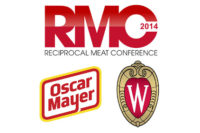Meat Science Review
AMSA RMC wrapup: Policing the future
Lusk challenges AMSA RMC attendees to make a difference in the future of the meat and poultry industries.

Jayson Lusk, Ph.D., author of “The Food Police” and professor, Oklahoma State University, speaks to attendees at the 67th Reciprocal Meat Conference in Madison, Wis., in June.
 "Tell your story and communicate, but then you actually have to do stuff too,” stated Jayson Lusk, Ph.D., author of “The Food Police” and professor, Oklahoma State University, at the American Meat Science Association’s (AMSA) 67th Reciprocal Meat Conference (RMC).
"Tell your story and communicate, but then you actually have to do stuff too,” stated Jayson Lusk, Ph.D., author of “The Food Police” and professor, Oklahoma State University, at the American Meat Science Association’s (AMSA) 67th Reciprocal Meat Conference (RMC).
Lusk’s opening keynote address set the tone to celebrate AMSA’s 50th anniversary at the conference held in Madison, Wis., June 15-18, 2014. After looking back at the past 50 years and the many accomplishments made by the members of AMSA, it was time to look to the future and set out for greatness in the next 50 years.
Lusk has become world-renowned for his work in bridging the gap between consumers and producers. He provided the future leaders of the meat industry with great insight on how to reach out to the evolving consumers by overcoming the challenges facing the industry.
According to Lusk, the meat industry faces four challenges. The first of these, price pressures, which is controlled solely by the consumer.
“As prices rise, consumers are going to turn to other cheaper food sources,” Lusk said. “We can look at surveys and graphs, but the most important thing is how people actually spend their dollar.”
In order to avoid losing these customers, Lusk recommends we implement more technological innovation and eliminate government policies — and we need it to rain and end the drought.
The next issue facing the industry is social pressures on demand.
“Social pressures on demand provide the most difficult things to combat with in the meat industry,” Lusk said. “Consumers don’t know the facts.”
Consumers are concerned with the impact agriculture has on the environment, human health and animal welfare. The problem is their lack of knowledge, and that is one of the calls to action Lusk presented to the group.
The third challenge is just that: remedying the lack of consumer knowledge.
“The harsh reality is that people have had the basic necessity to eat for survival. Things are different now,” Lusk said. “Consumers want to have a safe product and currently think what they are eating is harmful.”
It has become the meat industry’s responsibility to inform them the products they are purchasing and consuming are safe and nutritious.
The final challenge Lusk presented was to create a strategic vision for the future. This challenge provided the perfect closure that the AMSA RMC attendees needed to set out and prepare to fulfill greatness.
Lusk provided the AMSA RMC group with great insight on how to reach the quickly progressing consumer and ensure the meat industry continues to prosper, by ending with a reminder of why consumers think the way they do.
“The intent of humans is to romanticize the past,” he said. “People like things to be the way they were and don’t like that food is an ever-changing and evolving thing.”
With the help of Lusk’s four challenges, the attendees of the AMSA 67th RMC undoubtedly were well-prepared to make a difference as they engaged in scientific workshops and networked throughout the week — and then go out from the conference, take action and change the future.
For more information about AMSA and the upcoming RMC please visit www.meatscience.org.
Looking for a reprint of this article?
From high-res PDFs to custom plaques, order your copy today!



